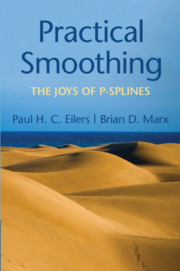Refine search
Actions for selected content:
1004 results in Computational statistics, machine learning and information science
6 - Complex Counts and Composite Links
-
- Book:
- Practical Smoothing
- Published online:
- 25 February 2021
- Print publication:
- 18 March 2021, pp 103-113
-
- Chapter
- Export citation
4 - Multidimensional Smoothing
-
- Book:
- Practical Smoothing
- Published online:
- 25 February 2021
- Print publication:
- 18 March 2021, pp 59-83
-
- Chapter
- Export citation
Appendix B - P-splines and Competitors
-
- Book:
- Practical Smoothing
- Published online:
- 25 February 2021
- Print publication:
- 18 March 2021, pp 161-167
-
- Chapter
- Export citation
Appendix G - The Website
-
- Book:
- Practical Smoothing
- Published online:
- 25 February 2021
- Print publication:
- 18 March 2021, pp 184-187
-
- Chapter
- Export citation
Index
-
- Book:
- Practical Smoothing
- Published online:
- 25 February 2021
- Print publication:
- 18 March 2021, pp 196-200
-
- Chapter
- Export citation
Appendix D - Array Algorithms
-
- Book:
- Practical Smoothing
- Published online:
- 25 February 2021
- Print publication:
- 18 March 2021, pp 174-175
-
- Chapter
- Export citation
Preface
-
- Book:
- Practical Smoothing
- Published online:
- 25 February 2021
- Print publication:
- 18 March 2021, pp xi-xii
-
- Chapter
- Export citation
Appendix C - Computational Details
-
- Book:
- Practical Smoothing
- Published online:
- 25 February 2021
- Print publication:
- 18 March 2021, pp 168-173
-
- Chapter
- Export citation
Dedication
-
- Book:
- Practical Smoothing
- Published online:
- 25 February 2021
- Print publication:
- 18 March 2021, pp v-vi
-
- Chapter
- Export citation
1 - Introduction
-
- Book:
- Practical Smoothing
- Published online:
- 25 February 2021
- Print publication:
- 18 March 2021, pp 1-5
-
- Chapter
-
- You have access
- Export citation
5 - Smoothing of Scale and Shape
-
- Book:
- Practical Smoothing
- Published online:
- 25 February 2021
- Print publication:
- 18 March 2021, pp 84-102
-
- Chapter
- Export citation
3 - Optimal Smoothing in Action
-
- Book:
- Practical Smoothing
- Published online:
- 25 February 2021
- Print publication:
- 18 March 2021, pp 36-58
-
- Chapter
- Export citation
2 - Bases, Penalties, and Likelihoods
-
- Book:
- Practical Smoothing
- Published online:
- 25 February 2021
- Print publication:
- 18 March 2021, pp 6-35
-
- Chapter
- Export citation
Appendix F - Standard Errors in Detail
-
- Book:
- Practical Smoothing
- Published online:
- 25 February 2021
- Print publication:
- 18 March 2021, pp 182-183
-
- Chapter
- Export citation
8 - Special Subjects
-
- Book:
- Practical Smoothing
- Published online:
- 25 February 2021
- Print publication:
- 18 March 2021, pp 131-158
-
- Chapter
- Export citation
References
-
- Book:
- Practical Smoothing
- Published online:
- 25 February 2021
- Print publication:
- 18 March 2021, pp 188-195
-
- Chapter
- Export citation
Appendix A - P-splines for the Impatient
-
- Book:
- Practical Smoothing
- Published online:
- 25 February 2021
- Print publication:
- 18 March 2021, pp 159-160
-
- Chapter
- Export citation
7 - Signal Regression
-
- Book:
- Practical Smoothing
- Published online:
- 25 February 2021
- Print publication:
- 18 March 2021, pp 114-130
-
- Chapter
- Export citation

Practical Smoothing
- The Joys of P-splines
-
- Published online:
- 25 February 2021
- Print publication:
- 18 March 2021
4.4 - Legal Operations at Google
- from B. - Large Firm and Corporate Legal Informatics Case Studies
-
-
- Book:
- Legal Informatics
- Published online:
- 04 February 2021
- Print publication:
- 18 February 2021, pp 501-510
-
- Chapter
- Export citation
